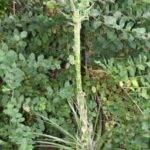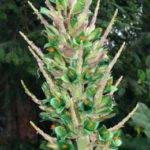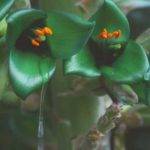In 1996, a specimen of this plant was donated to Glasnevin by the Talbot Botanic Gardens at Malahide Castle. The specimen was planted outside in a sheltered, semi-shaded spot. Over the last 12 years, a number of side plants have developed at the base, though this is the first year the specimen has flowered (right).
Puya alpestris is a species of Bromeliad native to the Chilean Andes. This stunning plant forms a 3-4 foot tall rosette of recurving, spiny-margined, light green leaves that are silver-grey beneath. The spiny leaves of the Puya plant are notorious in their native range for snaring birds and in some cases even sheep manage to get tangled in the clutches of this spiny beast.
The breathtaking teal-green flowers (sometimes referred to as metallic) are produced in erect panicles, the branches having sterile tips, which act as perches for hummingbird pollinators. At lower altitudes, some Puya species are pollinated by moths. In some cases, these large moths have been observed chasing off their hummingbird competitors to secure the plentiful supply of nutritious nectar within the flowers for themselves.
The flowers are followed by green fruit capsules containing winged seeds. This exotic species is surprisingly hardy in our climate, though in frost prone areas, growing under glass is recommended. The plant will be observed over the coming weeks and months to check for seed production. Once the fruits have ripened, seed will be collected for propagation in the Nursery at Glasnevin. Come and see it soon, you don’t want to have to wait another twelve years to see this botanical gem.



